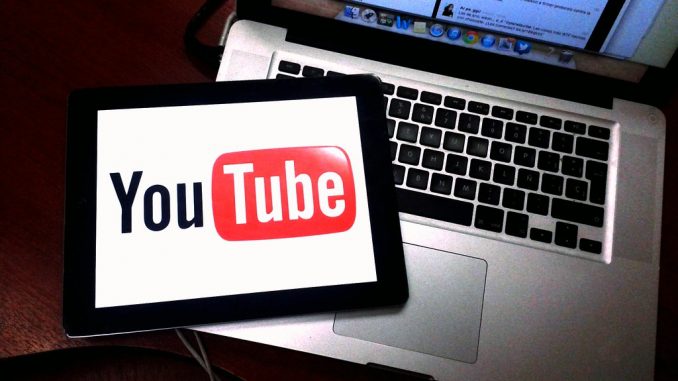
YouTube is one of the biggest video streaming platforms on the Internet and the second most visited website on the Internet just after Google.com, and is owned by the former company. The site is an online video sharing and social media platform was originally founded by Steve Chen, Chad Hurley, and Jawed Karim, in the early months of 2005 when its development idea originated from the difficulties of sharing videos taken at a dinner party at Chen’s apartment, as mentioned in the media (Leskin, 2020). This case study essay will present the collective knowledge and business model of YouTube. Afterward, it will focus on elaborating on how the video sharing service develops and attains overwhelming popularity and success under the management of Google; as well as addressing past and present concerns of its platform business.
HOW DOES YOUTUBE WORK
YouTube at its core is a website for people to easily store their video online and to share it with others on the Internet using the website itself or via other social media, messages, emails and as embedded video in other websites. Given that the content of the video is appropriate in accordance with YouTube’s community guidelines, they can cover all possible subjects of interest on any topic (Business Queensland, 2016). Accordingly, the contents of YouTube can appeal to various demographics of viewers with the adolescent and young adult demographics making up the largest percentage by age at 77% (Statista, Q3 2020).

Similar to many social media sites, YouTube encourages its audience to interact with the videos they watch through simple acts of expressing their opinions and sharing the contents that they watch with others. Viewers may post comments discussing with others or with the uploader of the videos they watched in the comment section and express whether they liked or disliked the videos via the respective buttons.
The population of participants on YouTube is generally categorized into two sets, the subscribers, the audience of this video streaming platform, and the YouTubers, the content creators that upload videos onto the site. As a user-generated content based platform, content creators are considered the most valuable members of YouTube for user-generated content. And to manage the 500 hours of videos uploaded per minute (Statista, Feb 2020), To help manage the ever increasing pool of videos on their website, YouTube introduces tools of management respective for each participating party on their website.
To promote watch time amongst its viewers, YouTube has the video suggestion algorithm to present to its audience a variety of options of video topics that are likely to interest them through the calculation of the user’s data on YouTube. The algorithm also affects content creators, as YouTubers with frequent video releases will be exposed more to user’s traffic on the video-sharing platform. More information regarding the algorithm will be discussed later in this essay.
YouTubers are provided with means of managing contents on their channel, to organise playlists, site videos as public or private, schedule preview and live stream, etc. One of the more useful tools praised by many content creators of the video-sharing media is YouTube Analytics, a self-serviced analytics and reporting tool to track and process data of their videos. The data analysis features present YouTubers with informatic of how their contents have performed along with suggestions to further improve their pursuit of a content creator career.
YOUTUBE AS A PLATFORM BUSINESS

Japan, Tutorial, Movie, The Media, Watching by Metamorwork is licensed under CC BY-SA 2.0
YouTube’s diversity in the medium through which it delivers content was achieved by entering partnerships with companies and firms, contracted with film makers and acquired platform service company Next New Networks. After the acquisition by Google in November 2006, YouTube continued to operate as it did before and experienced significant development to its system and business model. All of these factors and decisions helped Youtube attract gargantuan amounts of viewership and keep them engaged in the long term.
YouTube’s business model as a platform service that creates revenue primarily based on advertisements and paid services, reflected in its relationships between subscribers and content creators as mentioned above, is a leading force in its success as a social media platform and as a business (Djick, 2018). YouTube monetized advertising by implementing features which allows businesses to promote their content to potential audiences by choosing viewers based on their demographic and interests. Advertisers can customize how they want their promotion to look like on the site and will be charged every time a person views their videos (Business Queensland, 2016). Additionally, Youtube also provides data for targeted advertising and encourages advertisers to create quality content on Youtube’s platform to go along with their advertisements (Postigo, 2014). Youtube offers two membership services in the form of Youtube Premium and Youtube Music. Users with a membership are able to receive premium content and features such as disabling advertisements and original content. Youtube’s final revenue source is its music streaming service called Youtube Music Pass in which Youtube charges music producers for access to their streaming platform.
THE CONCERNS & RISKS

Growing into a website with millions of users in the current day, YouTube must be able to properly navigate and manage its social spaces to address the many ethical and political issues that may arise from hosting a social media mainly attributed to user-generated contents.
The plentiful amount of content on YouTube also presents the dilemma that not all videos are appropriate for everyone, specifically children of age 13 and under. Previously, YouTube was under the investigation of the U.S. government for complaints that YouTube’s service is insufficient to protect the younger audience and their user data collection on children is a violation to the Children’s Online Privacy Protection Act (COPPA, 1998). The event concluded with the introduction of a new platform named YouTube Kid, which aims to provide a better control and protected digital space for children (Romm, Dwoskin & Timberg, 2019)
Despite being one of the more dominant platforms on the Internet, there have been reports of YouTube falling short on its ability to support and protect the YouTubers, the content creators, and also that of its own employees. Multiple reports claimed how the content creators of the popular video sharing media have been experiencing severe episodes of “burnt out” because of working overtime to keep up with regular uploading schedules; their logic of forcing themselves to work can be explained with how the current video recommendation algorithm on YouTube works, which favor the YouTube channel with more consistent and frequent uploads (Hermandez, 2018). However, the issue is further intensified, for reasons that many YouTubers cannot fully understand, when videos become demonetized or are simply hidden from subscribers who are interested in their contents (Maloney & Hudson, 2018), in both cases the great amount of effort invested to create videos for YouTube is often detriment more detriment that profitable to content creators. YouTube’s response to the situation still lacked the reasonable resources to be truly supportive for their creators. Due to the fact that most of the participants on their site can be described as freelancers, not truly workers, YouTubers do not have access to health benefits or the security of paid time off. The current recommendation algorithm on YouTube pritoritizes channels with daily upload frequency, and as a result, the contents makers of this platform shy away from any form of vacation in fear that they would lose the exposure that they had worked tirelessly and meticulously for.
“Human beings are not disposable, and it’s time YouTube started acting like it.” – Patricia Hermandez, 2019.
In recent years, YouTube was sued by their own content moderator for the reason that it failed to provide adequate protection to its employees who were tasked to moderate and remove inappropriate mediums on the site. A short description of the case follows the event where employees of the moderating department have bare minimum well-being and health support while constantly forced to moderate highly sensitive contents, that many claimed to leave “psychological scars” (Crump, 2020). Currently, YouTube has integrated a programmed AI to its moderating system to help alleviate the weight on its employees along with a significantly improved protection policy for its content moderators.

CONCLUSION
The case of Youtube provides insight on the workings of a video sharing platform. Utilizing suggestion algorithms, Youtube can attract and retain vast quantities of users and accumulate stores of content from creators and users themselves. By capitalizing on this asset, Youtube can diversify its revenue streams from monetizing advertisements to paid membership or services. However, there are rising public concerns on Youtube’s operations such as their inability to protect children’s user data, their recommendation algorithms overwork their content creators and unhealthy labor conditions for their staff. YouTube as an online business platform would still need to strive further in their endeavor to create a sustainable social digital environment for its employees, creators and audiences.
REFERENCES
Business Queensland. (8 June 2020). How YouTube works. Retrieved October 14, 2021, from https://www.business.qld.gov.au/running-business/marketing-sales/marketing-promotion/online-marketing/youtube/how
Casper Gelderblom. (2019). Van Dijck J., Poell T., and De Waal M., (2018), The Platform Society, New York: Oxford University Press. https://doi.org/10.1285/i20356609v12i3p980
Crump. (22 September 2020). Former YouTube content moderator sues site and accuses it of failing to protect employees. Retrieved October 14, 2021, from https://www.independent.co.uk/news/world/americas/youtube-content-moderator-new-lawsuit-failing-protect-employees-b537264.html
Hermandez. (21 September 2018). YouTube is failing its creators. Retrieved October 14, 2021 from https://www.theverge.com/2018/9/21/17879652/youtube-creator-youtuber-burnout-problem
Code of Federal Regulations. (2013). Part 312 – Children’s online privacy protection rule. Retrieved from https://www.ecfr.gov/current/title-16/part-312
Leskin. (30 May 2020). YouTube is 15 years old. Here’s a timeline of how YouTube was founded, its rise to video behemoth, and its biggest controversies along the way. Retrieved October 14, 2021, from https://www.businessinsider.com/history-of-youtube-in-photos-2015-10
Malony & Hudson. (17 April 2018). YouTube CEO addresses demonetization, ignores frustrated small creators. Retrieved October 14, 2021, from https://www.theverge.com/2018/4/17/17249016/youtube-ceo-addresses-demonetization-partners-program-advertising
Postigo, H. (2014). The socio-technical architecture of digital labor: Converting play into YouTube money. New Media & Society, 18(2), 332-349. doi: 10.1177/1461444814541527
Romm, Dwoskin & Timberg. (19 June 2019). YouTube under federal investigation over allegations it violates children’s privacy. Retrieved October 14, 2021, from https://www.washingtonpost.com/technology/2019/06/19/facing-federal-investigation-youtube-is-considering-broad-changes-childrens-content/
Statista Research Department. (23 August 2021). YouTube usage penetration in the United States 2020, by age group. Retrieved October 14, 2021, from https://www.statista.com/statistics/296227/us-youtube-reach-age-gender/
Statista Research Department. (14 September 2021). Hours of video uploaded to YouTube every minute 2007-2020. Retrieved October 14, 2021, from https://www.statista.com/statistics/259477/hours-of-video-uploaded-to-youtube-every-minute/

YouTube: Case study of the most popular video platform in the world by Finn Dang is licensed under a Creative Commons Attribution-NonCommercial 4.0 International License.